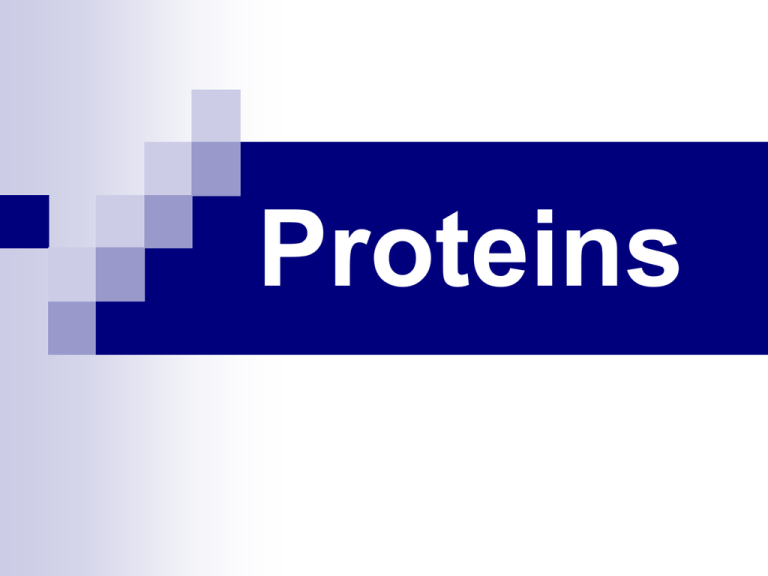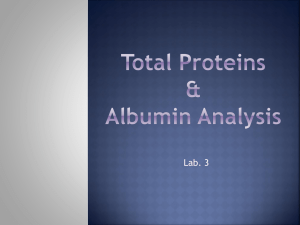Proteins
advertisement

Proteins Introduction Proteins are polymers of amino acids produced by living cells in all forms of life. A large number of proteins exist with diverse functions, sizes, shapes and structures but each is composed of essential and non-essential amino acids in varying numbers and sequences. The number of distinct proteins within one cell is estimated at 3,000 - 5,000 The most abundant organic molecule in cells (50-70% of cell dry weight) 2 M. Zaharna Clini. Chem. 2015 Size A typical protein contains 200-300 amino acids, but some are much smaller and some are much larger Proteins range in molecular weight from 6,000 Daltons (insulin) to millions of Daltons (structural proteins) 3 M. Zaharna Clini. Chem. 2015 Peptide bond 4 M. Zaharna Clini. Chem. 2015 Protein Structure Primary structure Sequence of AA In order to function properly, proteins must have the correct sequence of amino acids. e.g when valine is substituted for glutamic acid in the chain of HbA, HbS is formed, which results in sickle-cell anemia. 5 M. Zaharna Clini. Chem. 2015 Protein Structure Secondary structure A regularly repeating structures stabilized by hydrogen bonds between the amino acids within the protein Initial helical folding (α helix) Beta pleated sheet Held together by Hydrogen bonding 6 M. Zaharna Clini. Chem. 2015 Protein Structure Tertiary Structure The overall shape, or conformation, of the protein molecule Chain folds back on itself to form 3D structure Interaction of R groups (hydrogen bonds, and disulfide bonds) Responsible for biologic activity of molecule M. Zaharna Clini. Chem. 2015 7 Protein Structure Quaternary structure The shape or structure that results from the interaction of more than one protein molecule, or protein subunits, held together by noncovalent forces such as hydrogen bonds and electrostatic interactions 2 or more polypeptide chains binding together eg. Hemoglobin Hemoglobin has 4 subunits Two chains Two chains Many enzymes have quaternary structures M. Zaharna Clini. Chem. 2015 8 Protein Structure Disruption of bonds holding 2o, 3o or 4o structure together is called denaturation and can cause loss of function of the protein These Bonds that hold the protein together are weak It is important in the clinical lab to note that excessive heat, freeze thaw cycle or vigorous mixing can break these bonds and denature the protein An enzyme can loose its activity, Ag can loose its antigenicity 9 M. Zaharna Clini. Chem. 2015 Protein Charges Proteins contain many ionizable groups on the side chains of their amino acids as well as their N- and Cterminal ends A protein can bear positive and/or negative charges on each molecule, due to amino acid composition pH dependent Aspartic acid has: no net charge at pH 2.8, but a net negative charge at pH 9.47 Lysine has: no net charge at pH 9.47, but a net positive charge at acid pH M. Zaharna Clini. Chem. 2015 10 Protein Charges 11 M. Zaharna Clini. Chem. 2015 Protein Charges Isoelectric point (pI) – The pH at which an amino acid or protein has no net charge The point at which the number of positively charged groups equals the number of negatively charged groups in a protein When the pH > pI, a protein has a net negative charge When the pH < pI, a protein has a net positive charge 12 M. Zaharna Clini. Chem. 2015 Solubility Soluble proteins have a charge on their surfaces. A protein has its lowest solubility at its isoelectric point Without a net charge, protein-protein interactions and precipitation are more likely The solubility of proteins in blood requires a pH in the range of 7.35-7.45. Differences in solubility can be used to separate major plasma fractions from each other 13 M. Zaharna Clini. Chem. 2015 Classification by Protein Structure Simple Proteins (contain only amino acids) are classified by shape as – Globular proteins: compact, tightly folded and coiled chains Majority of serum proteins are globular Fibrous proteins: elongated, high viscosity (hair, collagen) 14 M. Zaharna Clini. Chem. 2015 Classification by Protein Structure Conjugated proteins contain non-amino acid groups Amino acid portion is called apoprotein and nonamino acid portion is called the prosthetic group The prosthetic group may be lipid, carbohydrate, porphyrins, metals, and others It is the prothetic groups that define the characteristics of these proteins. Name of the conjugated protein is derived from the prosthetic group 15 M. Zaharna Clini. Chem. 2015 Conjugated Proteins Classification Example Lipoprotein Prosthetic group Lipid Glycoprotein Carbohydrates Phosphoprotein Phosphate Immunoglobulins Casein of milk HDL 16 M. Zaharna Clini. Chem. 2015 Functions of proteins Generally speaking, proteins do everything in the living cells Functional classification of plasma proteins is useful in understanding the changes that occur in disease: Tissue nutrition Proteins of immune defense Antibodies Acute phase proteins Proteins associated with inflammation Transport proteins( albumin, transferrin) Proteins used to bind and transport Hemostasis Proteins involved in forming clots and acting very closely with complement 17 M. Zaharna Clini. Chem. 2015 Functions of proteins Regulatory ( receptors, hormones ) Catalysis, enzymes Osmotic force Maintenance of water distribution between cells and tissue and the vascular system of the body Acid-base balance Participation as buffers to maintain pH Structural, contractile, fibrous and keratinous 18 M. Zaharna Clini. Chem. 2015 Catabolism & Nitrogen Balance Most proteins in the body are constantly being repetitively synthesized and then degraded Balance exists between protein anabolism (synthesis) and catabolism (breakdown) Turnover totals about 125-220 g of protein each day Normal, healthy adults are generally in nitrogen balance, with intake and excretion being equal Pregnant women, growing children, and adults recovering from major illness are often in positive nitrogen balance 19 M. Zaharna Clini. Chem. 2015 Catabolism & Nitrogen Balance Conditions in which there is excessive tissue destruction, such as burns, wasting diseases, continual high fevers, or starvation. more nitrogen is excreted than is incorporated into the body, an individual is in negative nitrogen balance 20 M. Zaharna Clini. Chem. 2015 Plasma Proteins About 500 proteins have been identified in plasma The plasma proteins include the immunoglobulins, enzymes, and enzyme inhibitors. Most plasma proteins, with the notable exception of immunoglobulins, are synthesized in the liver. Plasma proteins circulate in the blood and between the blood and the extracellular tissue spaces. 21 M. Zaharna Clini. Chem. 2015 Plasma Proteins Prealbumin Albumin Globulins α1, α2, β, and γ • α2 Macroglobulin • Transferrin (Siderophilin) β • Hemopexin • Acute phase proteins (CRP) • Immunoglobulins • α1-Antitrypsin • α1-Fetoprotein • α1-Acid Glycoprotein Myoglobin • Haptoglobin (α2) Troponin • Ceruloplasmin 22 M. Zaharna Clini. Chem. 2015 Prealbumin (Transthyretin) Migrates just ahead of Albumin When a diet is deficient in protein, hepatic synthesis of proteins is reduced Indicator of nutritional status (very short half life- 2 days) Transport of thyroid hormones & retinol (vitamin A) 23 M. Zaharna Clini. Chem. 2015 Prealbumin (Transthyretin) Low levels found in: Hepatic damage Acute phase responses (-ve acute phase reactant) Nutritional deficit – short half-life means decrease seen early in disease Increased level found in: Steroid treatment Alcoholism Chronic renal failure (glomerular filtration rate decreased) 24 M. Zaharna Clini. Chem. 2015 Albumin Synthesized in the liver from 585 amino acids at the rate of 9–12 grams per day with no reserve or storage Highest concentration plasma protein Albumin also exists in the exrtavascular (interstitial) space Two primary functions Colloidal osmotic pressure (80%) Bind and transport of numerous substances Bilirubin, steroids, fatty acids, Ca++, Mg++, salicylic acid & other medications M. Zaharna Clini. Chem. 2015 25 Albumin Albumin Decreased Albumin Malnutrition & muscle wasting diseases Liver diseases – inability to synthesize GI loss due to inflammation or mucosal lining diseases Loss in urine due to renal disease Genetic analbuminemia (Mutation causes absence of albumin) Bisalbuminemia results from two copies of different albumin genes, resulting in different charges. 26 M. Zaharna Clini. Chem. 2015 Albumin Increased levels of Albumin Seen in dehydration After excessive albumin infusion 27 M. Zaharna Clini. Chem. 2015 Globulins The globulin group of proteins consists of α1, α2, β, and γ fractions. Each fraction consists of a number of different proteins with different functions. 28 M. Zaharna Clini. Chem. 2015 Globulins (α1-Antitrypsin) Major component (90%) of α1 fraction Acute phase reactant, synthesized in the liver Most important function the inhibition of the protease neutrophil elastase Neutrophil elastase is released from leukocytes to fight infection, but it can destroy alveoli Mutations in the SERPINA1 gene cause: α1-antitrypsin deficiency which is associated with Severe degenerative emphysema Abnormal form of α1-antitrypsin can also accumulate in the liver and can cause cirrhosis 29 M. Zaharna Clini. Chem. 2015 α1-Antitrypsin Increased levels in: Inflammatory reactions Pregnancy Contraceptive use Since major component of α1 band – changes in levels apparent on protein electrophoresis Quantitative methods used to confirm electrophoresis findings are radial immunodiffusion 30 M. Zaharna Clini. Chem. 2015 α1-Fetoprotein (AFP) AFP synthesized by fetal yolk sac later by parenchymal cells of liver Peaks in fetus at 13 weeks – decreases gradually by birth Acts like a fetal “albumin” Maternal serum testing used to screen fetus for birth defects Neural tube defects Down’s syndrome 31 M. Zaharna Clini. Chem. 2015 α1-Fetoprotein (AFP) In adults level is high in: 80% of hepatocellular carcinoma Gonadal tumors in adults The methods commonly used for AFP determinations are radioimmunoassay (RIA) and enzyme-labeled immunoassay (EIA) 32 M. Zaharna Clini. Chem. 2015 α1-Acid Glycoprotein (AAG) Acute phase reactant, synthesized in the liver Regulates immune responses Increased in: inflammation, cancer, pneumonia, Rheumatoid arthritis (RA). The analytic methods used most commonly for the determination of AAG are radial immunodiffusion, immunoturbidity, and nephelometry 33 M. Zaharna Clini. Chem. 2015 Haptoglobin (α2) Synthesized in the liver Considered an acute-phase protein Binds free hemoglobin Prevents loss of Hemoglobin & Iron into urine Used to detect and evaluate hemolytic anemia and to distinguish it from anemia due to other causes 34 M. Zaharna Clini. Chem. 2015 Haptoglobin (α2) Increased in Inflammations, burns & nephrotic syndrome due to fluid losses Decreased in with transfusion reactions, HDN Thus, a low plasma haptoglobin concentration can be indicative of intravascular haemolysis. decreased synthesis are seen in chronic liver disease Radial immunodiffusion has been used for the quantitative determination of haptoglobin 35 M. Zaharna Clini. Chem. 2015 Ceruloplasmin (α2) Synthesized in the liver acute-phase reactant Copper carrying protein 90% of serum copper is bound to it Ordered along with blood and/or urine copper tests to help diagnose Wilson's disease, decreased levels of ceruloplasmin and excess storage of copper in the liver, brain, and other organs resulting in hepatic cirrhosis and neurologic damage. 36 M. Zaharna Clini. Chem. 2015 Ceruloplasmin Increased levels Pregnancy, inflammatory processes, malignancies, oral estrogens & contraceptives Low levels Malabsorption Severe Liver Disease Nephrotic syndrome Menkes’ Syndrome (decreased Cu absorption) Most assays today use immunochemical methods, including radial immunodiffusion and nephelometry 37 M. Zaharna Clini. Chem. 2015 α2 Macroglobulin Tetramer of four identical subunits Synthesized by liver major component of the α2 band in protein electrophoresis Primarily intravascular spaces due to size Inhibits proteases trypsin, pepsin & plasmin 38 M. Zaharna Clini. Chem. 2015 α2 Macroglobulin Increased levels Nephrosis (Large size prevents loss) Oral contraceptives (high estrogens) Decreased levels Pancreatitis The analytic methods that have been used for the assay of this protein are radial immunodiffusion, ELISA, and latex agglutination immunoassay. M. Zaharna Clini. Chem. 2015 39 Transferrin (Siderophilin) The major component of the -globulin. Glycoprotein synthesized by liver Carries 2 ferric iron molecules Normally 33% saturated Prevents loss of iron through kidneys Transports to storage sites where Iron is transferred to ferritin Transports to bone marrow for RBC synthesis 40 M. Zaharna Clini. Chem. 2015 Transferrin (Siderophilin) Transferrin is abnormally high in iron deficiency anemia Decreased in general protein deficiencies Liver disease Malnutrition Inflammations (Negative acute phase protein) Hereditary Disorders The analytic method used for the quantitation of transferrin is immunodiffusion 41 M. Zaharna Clini. Chem. 2015 Hemopexin Beta globulin acute-phase reactant Purpose is to remove circulating Heme Breakdown product of Hemoglobin & myoglobin Carried to liver – broken down Increased in pregnancy, Some malignancies Low hemopexin levels are diagnostic of a hemolytic anemia Hemopexin can be determined by radial immunodiffusion M. Zaharna Clini. Chem. 2015 42 C-Reactive Protein Acute phase reactant CRP was so named because it precipitates with the C substance, a polysaccharide of pneumococci. Antibody-like reactivity for many bacteria Opsonization It is elevated in acute rheumatic fever, bacterial infections, myocardial infarction, rheumatoid arthritis, etc… 43 M. Zaharna Clini. Chem. 2015 Immunoglobulins IgA, IgD, IgE, IgG, IgM Consist of two identical heavy (H) and two identical light (L) chains Decreases seen in general protein deficiencies Increases Chronic inflammatory processes - polyclonal Malignancy (multiple myeloma) - monoclonal 44 M. Zaharna Clini. Chem. 2015 Myoglobin Heme protein of skeletal & cardiac muscle Single polypeptide chain transports oxygen to muscle tissue Released into blood when striated muscle is damaged Cardiac injury (AMI) Trauma or crush injuries Latex agglutination, ELISA 45 M. Zaharna Clini. Chem. 2015 Troponin Complex of 3 proteins that bind to filaments of striated muscle (cardiac & skeletal) Troponin T (TnT) Troponin I (TnI) Troponin C (TnC) Regulate muscle contractions Calcium release attaches troponin Increase indicative of myocardial injury Cardiac troponins can be measured by ELISA 46 M. Zaharna Clini. Chem. 2015 Hypoproteinemia Total protein level less than the reference interval, occurs in any condition where a negative nitrogen balance exists: Malnutrition and/or malabsorption Excessive loss as in renal disease, GI leakage, excessive bleeding, severe burns Excessive catabolism Burns, trauma, shock Liver disease Primary site of protein 47 M. Zaharna Clini. Chem. 2015 Hyperproteinemia Dehydration Relative due to fluid decrease Decreased intake or increased loss All fractions remain normal ratios Monoclonal increases Multiple Myeloma or related malignancies Polyclonal increases Chronic inflammatory diseases 48 M. Zaharna Clini. Chem. 2015








